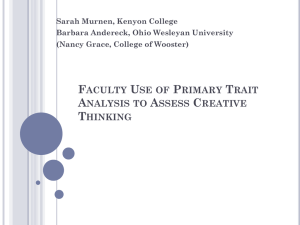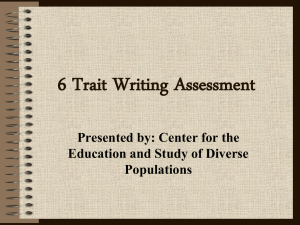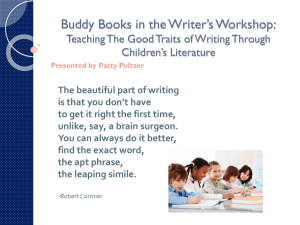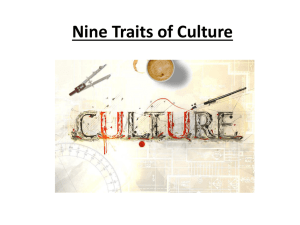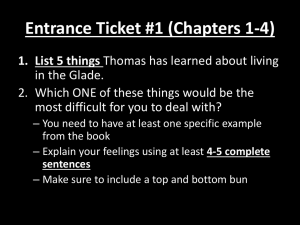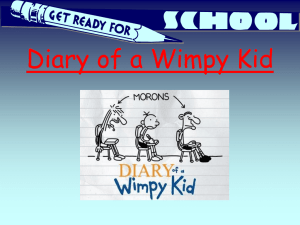File - Greenburgh Eleven UFSD
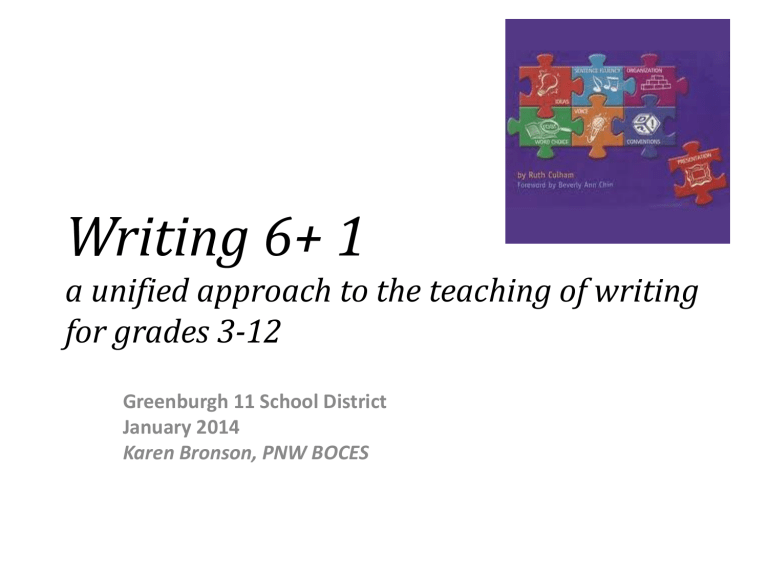
Writing 6+ 1
a unified approach to the teaching of writing for grades 3-12
Greenburgh 11 School District
January 2014
Karen Bronson, PNW BOCES
What is Writing 6 + 1?
The 6+1 Trait® Writing Model of Instruction
& Assessment provides a common language for teachers and students to communicate about the characteristics of writing and establishes a clear vision of what good writing looks like.
What is the history of 6+1?
Pioneered by Education Northwest more than 20 years ago, the 6+1 Traits continue to help thousands of teachers worldwide who have been trained in the model improve their writing instruction, their understanding of the qualities of good writing, and their ability to provide effective feedback to students. Ruth Culham
“wrote the book” on Writing 6+1
What are the benefits of 6+1?
• A shared vision and common words to define the traits of good writing
• A common language to assess writing and provide quality feedback to students and make students active self-evaluators
• Teacher and student friendly materials, visuals and resources
• Excellent fit with Common Core Shifts
• A proven track record of success over 20 years
Why is it called Writing 6+1?
Six Traits identify the qualities of good writing:
• IDEAS: the main message
• ORGANIZATION: the internal structure of the piece
• VOICE: the personal tone and flavor of the author
• WORD CHOICE: the vocabulary the author chooses
• SENTENCE FLUENCY: the rhythm and flow in the text
• CONVENTIONS: mechanical correctness
+ 1:
• PRESENTATION: overall appearance of the piece
Our goals today …
• To get familiar with the 6+1 traits and consider how this approach would work here at
Greenburgh 11
• To look at the supporting materials and rubrics
• To see examples of assessment using the rubrics
• To assess some pieces of student writing for our own practice
• To get some answers to FAQ’s about 6+1
Rubrics and Assessment:
• There are 4, 5 and 6 point rubrics (p. 11-13 of
“40”) Recommendation: Use the 5 point rubric because it aligns with the Student
Friendly Scoring Guides (pp. 266-272 Purple)
• There are also more detailed rubrics for each individual Trait (Grades 3-12 Traits Rubrics”
• There are also Scoring Guides for each Trait (p.
40, 76, 109, 147, 183, 225, 251 Purple)
What materials would we need?
• The book: 6+1 Traits of Writing: The Complete Guide
Grades 3 and Up by Ruth Culham, Scholastic 2003
• 40 Reproducible Forms for the Writing Traits Classroom by Ruth Culham and Amanda Wheeler, Scholastic 2003
• 100 Trait Specific Comments: A Quick Guide for Giving
Constructive Feedback on Student Writing by Ruth
Culham, Scholastic 2006
Trait 1: IDEAS
… the content of the piece
… the meaning and development of the message through specific details
… ideas are strong when the message is clear!
6+1 Teachers Say:
“the important thing about Ideas is the details. Ideas narrow the topic and make the piece original. They bring the message to life. They share knowledge or experience on the topic… but the most important thing about Ideas is the details!”
LOOK AT:
Grades 3-12 Traits Rubric for Ideas
IDEAS Quick Check for Students
Student PUBLISHING CHECKLISTS
Trait 2: ORGANIZATION
… the internal structure of the piece … the thread of meaning … the logical pattern of ideas … can be built using many structures: comparison/contrast, analysis, development of a central theme, chronology … connections or bridges between ideas are strong …
6+1 Teachers Say:
“the important thing about Organization is that you’d get lost without it! It is a combination of time, space, sequence and ideas flowing together to achieve a goal.”
LOOK AT:
Grades 3-12 Traits Rubric for Organization
ORGANIZATION Quick Check for Students
Student PUBLISHING CHECKLISTS
Trait 3: VOICE
... the heart and soul of the piece … the magic, the wit, the life and breath … the writer’s feelings and convictions come out through the words when he or she is engaged with the topic… voice is what makes a writer’s work his or hers alone.
6+1 Teachers Say:
“Voice paints a picture of the writer. Heart and soul on paper… you can’t see the writer but you know he or she is there!”
LOOK AT:
Grades 3-12 Traits Rubric for Voice
VOICE Quick Check for Students
Student PUBLISHING CHECKLISTS
Trait 4: WORD CHOICE
… the use of rich, colorful, precise language that communicates in a way that moves and enlightens the reader. Depending on the mode
(descriptive, informative, persuasive) it can result in powerful imagery, a strong vision of ideas and enriched content. It’s not so much about exceptional vocabulary to impress, but rather the ability to use language precisely and well…
6+1 Teachers Say:
“Words are the idea spinners, the precision strikers, the lure … but the important thing is that they convey the intended message.”
LOOK AT:
Grades 3-12 Traits Rubric for Word Choice
WORD CHOICE Quick Check for Students
Student PUBLISHING CHECKLISTS
Trait 5: SENTENCE FLUENCY
… sentence fluency is the rhythm and flow of the language.
Fluent language has cadence and power. It is free of awkward patterns that slow the reader’s progress… sentences vary in length, beginnings, structure and style and are well crafted so that the reader can move through the piece with ease…
6+1 Teachers Say:
“The important thing is that it makes the writing flow … not choppy, awkward or unnatural.”
LOOK AT:
Grades 3-12 Traits Rubric for Sentence Fluency
SENTENCE FLUENCY Quick Check for Students
Student PUBLISHING CHECKLISTS
Trait 6: CONVENTIONS
… mechanical correctness that includes five elements: spelling, punctuation, capitalization, grammar/usage and paragraphing.
The essential question: “How much work would a copy editor need to do to prepare the piece for publication?” Grade level considerations are more in play in Trait 6 than in the others.
6+1 Teachers Say:
“Conventions are like signposts that signal your thinking and guides the way a piece should sound. The signposts map effective communication.”
LOOK AT:
Grades 3-12 Traits Rubric for Conventions
CONVENTIONS Quick Check for Students
Student PUBLISHING CHECKLISTS
+ 1: PRESENTATION
… such things as handwriting, neatness, layout, format are not part of Conventions. They belong here in Presentation. This
‘seventh trait’ is all about editing rather than revision.
6+1 Teachers Say:
“The most important thing about Presentation is that the paper looks good, like the writer took pride in the work. The margins, fonts, illustrations, charts all make the message of the piece clear.”
LOOK AT:
Grades 3-12 Traits Rubric for Presentation
PRESENTATION Quick Check for Students
Student PUBLISHING CHECKLISTS
Rubrics and Assessment:
• There are 4, 5 or 6 Point Rubrics to choose from (pp. 11-13 in
“40”). Recommendation: choose the 5 Point Rubric because it works with the Student Friendly Scoring Guides (p. 266-272 in
Purple).
• There are also more detailed Rubrics for individual traits:
“Grades 3-12 Traits Rubrics” (see packet)
• There are Scoring Guides for each trait to help you get familiar with assessment (p. 40, 76, 109, 147, 183, 225, 251
Purple)
The BIG IDEA:
• Change the approach, break the old model:
• You are the writing COACH . You PARTNER with students to support them in their writing.
• Focus is off grading and on focused, timely instruction and feedback. STUDENTS actively evaluate their own writing performance.
• From teacher directed to student centered writing instruction and support. Away from old ‘deficit models’ of writing instruction.
Let’s Practice …
For this activity we are going to focus upon
Trait 2: Organization:
– Start by reading Ruth Culham’s ditty on Organization (p. 69 Purple)
– Now read three papers:
• Paper #1: 9 th Grade “To be a good Techer”
• Paper #2: 9 th Grade “What are the Qualities of a Good Teacher?”
• Paper #3: 8 th Grade “A Good Teacher”
– Use the Five Point Rubric to assess the Organization trait. Assign it a
1-5 Score. Discuss your conclusion with your colleagues using the
Rubric for evidence and see if you come to consensus.
More practice …
For this activity, we are going to evaluate one piece on all Six Traits:
• Read Paper #11: 11 th Grade: “Driver’s License”
• Determine a score for each of the Six Traits using the
Five Point Rubric.
• Discuss your scores with a colleague, referring to the rubric for evidence. Do you come to consensus?
Aligning with Common Core and NYS
Assessments:
Look at the current NYS Grades 6-8 Writing
Evaluation Rubric and do a Crosswalk with the
6+1 Five Point Rubric:
– Where do you see alignment with 6+1?
– Where do you see gaps and what can be done to address them? (Hint: 6+1 is an approach, not a curriculum!)
How can one scoring guide address writing across such a wide span of grade levels?
• Qualities of good writing remain the same.
Think of them like the CC “anchor standards” that run consistently K-12.
• Anchor papers (benchmarks) at each grade level very important with respect to level of maturity and sophistication
Should we teach each trait separately or all of the traits at once?
• “All the traits all the time” is the mantra. Although you will certainly focus upon individual traits at different times and with individual students, do not assign certain traits to different grade levels, etc.
They do not develop in isolation. Your students’ needs are your guide with respect to the traits you need to focus upon.
• The Traits are NOT a curriculum. They are a shared vision and vocabulary to define good writing.
How do we get students to buy in?
• Stress the basics of the qualities that define good writing. Reassure students this won’t change year to year depending on which teacher they have.
Essential that STUDENTS are speaking the lingo as well as you are. They need to use the words of the Traits in connection with their writing.
• Students will like to evaluate other students’ writing using the Rubrics. Don’t use samples from your class. Use samples provided (or anonymous samples from other teachers and grade levels.)
How do we align with CC and NYS assessments?
• Minimize personal narrative prompts.
Maximize text based prompts.
• Learn and teach students the “language of the
Core” (evidence, argument, text-based ..) and integrate into writing practice. More on this to come …
What about grading writing?
To be continued! Meanwhile, read pp. 277-278 in Purple ….
We have more work to do! For now, take a minute and do a one minute “Elevator Speech” in which you sum up what you know now about
Writing 6+1.

